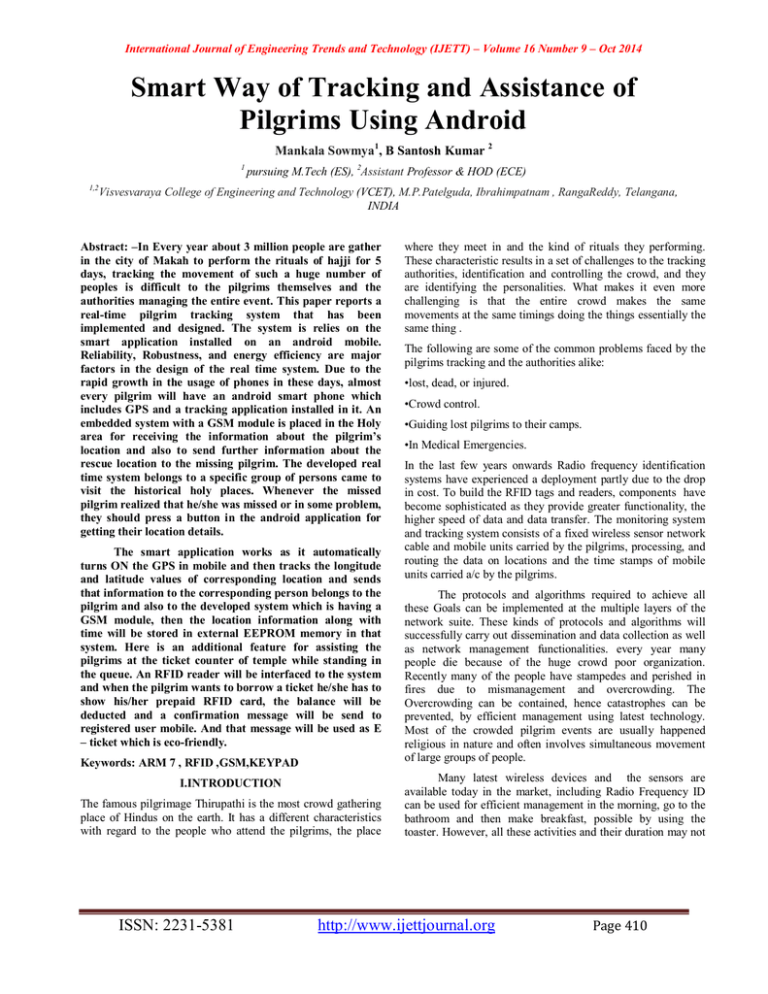Smart Way of Tracking and Assistance of Pilgrims Using Android Mankala Sowmya
advertisement

International Journal of Engineering Trends and Technology (IJETT) – Volume 16 Number 9 – Oct 2014 Smart Way of Tracking and Assistance of Pilgrims Using Android Mankala Sowmya1, B Santosh Kumar 2 1 1,2 pursuing M.Tech (ES), 2Assistant Professor & HOD (ECE) Visvesvaraya College of Engineering and Technology (VCET), M.P.Patelguda, Ibrahimpatnam , RangaReddy, Telangana, INDIA Abstract: –In Every year about 3 million people are gather in the city of Makah to perform the rituals of hajji for 5 days, tracking the movement of such a huge number of peoples is difficult to the pilgrims themselves and the authorities managing the entire event. This paper reports a real-time pilgrim tracking system that has been implemented and designed. The system is relies on the smart application installed on an android mobile. Reliability, Robustness, and energy efficiency are major factors in the design of the real time system. Due to the rapid growth in the usage of phones in these days, almost every pilgrim will have an android smart phone which includes GPS and a tracking application installed in it. An embedded system with a GSM module is placed in the Holy area for receiving the information about the pilgrim’s location and also to send further information about the rescue location to the missing pilgrim. The developed real time system belongs to a specific group of persons came to visit the historical holy places. Whenever the missed pilgrim realized that he/she was missed or in some problem, they should press a button in the android application for getting their location details. The smart application works as it automatically turns ON the GPS in mobile and then tracks the longitude and latitude values of corresponding location and sends that information to the corresponding person belongs to the pilgrim and also to the developed system which is having a GSM module, then the location information along with time will be stored in external EEPROM memory in that system. Here is an additional feature for assisting the pilgrims at the ticket counter of temple while standing in the queue. An RFID reader will be interfaced to the system and when the pilgrim wants to borrow a ticket he/she has to show his/her prepaid RFID card, the balance will be deducted and a confirmation message will be send to registered user mobile. And that message will be used as E – ticket which is eco-friendly. Keywords: ARM 7 , RFID ,GSM,KEYPAD I.INTRODUCTION The famous pilgrimage Thirupathi is the most crowd gathering place of Hindus on the earth. It has a different characteristics with regard to the people who attend the pilgrims, the place ISSN: 2231-5381 where they meet in and the kind of rituals they performing. These characteristic results in a set of challenges to the tracking authorities, identification and controlling the crowd, and they are identifying the personalities. What makes it even more challenging is that the entire crowd makes the same movements at the same timings doing the things essentially the same thing . The following are some of the common problems faced by the pilgrims tracking and the authorities alike: •lost, dead, or injured. •Crowd control. •Guiding lost pilgrims to their camps. •In Medical Emergencies. In the last few years onwards Radio frequency identification systems have experienced a deployment partly due to the drop in cost. To build the RFID tags and readers, components have become sophisticated as they provide greater functionality, the higher speed of data and data transfer. The monitoring system and tracking system consists of a fixed wireless sensor network cable and mobile units carried by the pilgrims, processing, and routing the data on locations and the time stamps of mobile units carried a/c by the pilgrims. The protocols and algorithms required to achieve all these Goals can be implemented at the multiple layers of the network suite. These kinds of protocols and algorithms will successfully carry out dissemination and data collection as well as network management functionalities. every year many people die because of the huge crowd poor organization. Recently many of the people have stampedes and perished in fires due to mismanagement and overcrowding. The Overcrowding can be contained, hence catastrophes can be prevented, by efficient management using latest technology. Most of the crowded pilgrim events are usually happened religious in nature and often involves simultaneous movement of large groups of people. Many latest wireless devices and the sensors are available today in the market, including Radio Frequency ID can be used for efficient management in the morning, go to the bathroom and then make breakfast, possible by using the toaster. However, all these activities and their duration may not http://www.ijettjournal.org Page 410 International Journal of Engineering Trends and Technology (IJETT) – Volume 16 Number 9 – Oct 2014 happen exactly at the same time each day and may have some cyclic variations, such as depends on the seasons. In The winter season the person May wake up later and spend more time in the shower during the summer season. The sensors should be able to detect all these activities, notice the duration and time of each activity. In this project we are describing the setting up of a smart home to collect ADL data which will be used for learning machine behaviour and early prediction of onset of diseases. HAJJ (Pilgrimage) is the largest gathering of Muslims worldwide. It has unique characteristics with regards to the people who attend it (pilgrims), the place they meet in, and the rituals they perform. Such a setup poses a real challenge to the authorities in controlling the crowd, and identifying the people. What it makes even more challenge is that all pilgrims move at the same times and to the same places. The Hajj authorities control the quotas for pilgrims from each country. Yet, the number of visitors exceeds 6 million per year. This number is expected to reach 10 million in the upcoming future. While Hajj is a different spiritual experience for all the pilgrims, it poses the major challenges for all the sorts to the authorities feel responsible for facilitating this annual event. Some of the major difficulties facing pilgrims and the authorities alike include: identification of pilgrims (lost, dead, or injured), medical emergencies, guiding lost pilgrims to their respective camps, and congestion management. For such case of scenario, there is a need for a tracking system for identifying pilgrims. Passive and active RFID systems have been tested in the past with limited success. Other approaches such as imagebased identifying systems are not suitable for a huge crowd in the specific application. Thus, by using wireless sensor network for tracking pilgrims was started. In this real time system operates in two modes, in the tracking the status of the pilgrim and monitoring mode, which consists of portable embedded real time system with a GSM module. The status and location of the pilgrim can be traced by sending a text message with a predefined text. After receiving that text, the application will operates towards getting the pilgrims location. The data logging with time framing is also accomplished by using EEPROM interfaced with a LPC2148 microcontroller. The information will also send to hospitals in case of pilgrim is in emergency situation with some health problems. In the second mode, it works E – ticket generator with RFID technology. It also contains a purchase mode. In this mode the pilgrim is allowed to purchase any of the things using a card provided to him/her. II. SYSTEM DESCRIPTION This section gives the overview of the different types of modules we have used, the LCD module for displaying the data and GSM for sending and receiving the status of the missing pilgrims, whenever the person realized that he/she missed ,that time there is a button in android app ,so upon pressing that button we can easily identify the location of the person .whenever the button is pressed the GPS will on automatically ISSN: 2231-5381 and it will track the current location latitude and longitude values and send to the Mobile number of security manager or corresponding person. III. BLOCK DIAGRAM Power supply LCD Module Keypad LPC2148 Controller GSM Module RFID Reader Fig 1: Block Diagram Description A. Liquid crystal display: In this project we have used HITACHI company manufactured lcd for displaying the required data on the screen .in this module having total 16 pins.in that pins 8 are for data lines and most importantly we have 3 pins ,register select ,read /write, enable. the register select is having two specific functionalities if it is set it is going to act as a data register if it is clear going to act as a command register .So by using data register we can display the names, numbers etc.. On the lcd display. And also by using command register we can control the lcd operations like display on, display off, cursor on/off, cursor blinking etc all these can be done by using some command registers. Next is read/write pin by using this pin we can read or write to the lcd is possible, suppose we wanted to write some tittle on the display by setting this r/w pin as 1 ,suppose we wanted to read data from the lcd by putting 0 on this pin we can read from the lcd module. The next is enable by sending high to low pulse to the controller we are latching the information from the data lines. B. GSM Module: The gsm module used in this project is sim900, by using this module we are tracking the missing persons by sending predefined text in the system which is fixed with piligrims. Otherwise whenever the person notified that he/she in a wrong way ,we have a button in android app ,whenever that button is pressed the inbuilt gsm automatically switching on and track the current location latitude and longitude values sending to the authorised persons.in the entry gate for every pilgrim details are taken and also given one RFID card for every person http://www.ijettjournal.org Page 411 International Journal of Engineering Trends and Technology (IJETT) – Volume 16 Number 9 – Oct 2014 ,whenever the person shows the RFID card the balance will be reduced from the card and also sends to his mobile that information regarding the requirement, so that message is the E-ticket for the entry into the locations. C. GPS Module: The GPS module is interfaced with the LPC2148 controller, the GPS module is always receives information from the satellite so we are connected in receive mode, the GPS gives the latitude and longitude values continuously in the GPGGA sentence. Based on the request time we are comparing the latitude and longitude values, the extraction of location values is identity’sand sends those values to the corresponding person.The extraction of location values is identifying as follows. The bytes of the data received are compared with the predefined ($GPGGA) number and if it matches then copying the values into an array otherwise the process is going to repeat again. After the stored values in the array are displaying on the LCD. D. RFID Module: The Radio-frequency identification and detection reader is a device which is used to communicate with the RFID tags by transmitting and receiving signals. These signals use radio waves for wireless communication with RFID tag is applied to products, is to identify and track them. The identification is based through a unique serial number.in this project we are using to identifying the missing person details ,based on those information we can also trace the person by sending text ,the current text and previous text matches it gives the person present location. The Fig 2 describes the overall schematic representation of project which have several modules interfaced to Microcontroller. Specific procedures are as below: 1.First of all check all the hardware connections of the system and then, apply power supply of 5v to the system. 2. After that the system initializes all the hardware modules interfaced with the system. 3. The real time tracking system is placed with every pilgrim, whenever the person feels that he is in wrong place, we have an android app which is interfaced with our system. 4. Whenever the button is pressed, the GPS automatically turns on, and tracks the latitude and longitude values. 5. Those latitude and longitude values are sends by using gsm to the corresponding person. 6. The system also having facility is that, we can support for eco-friendly environment, by using rechargeable RFID cards. 6. Whenever the person swipes his card, by using gsm the message will be sent to the particular personmobile, that message is used as an E-ticket. V.CONCLUSION Based on the tracking of pilgrims in missing cases the tracking system plays an major role, this system is easy to carry from one place to other and wireless transmission, cheaper in cost, maintenance is easy, and the efficiency is good, this experiment adopts self-made message sending to the corresponding person and automatic switching of GPS, an most importantly by this system we can create an eco-friendly environment in the society. Apart from this, maintenance is simple in structure, easy to operate remotely, we can come to know the status of the pilgrim by sending predefined text, and every time there is an automatic display and wireless transmission VI .REFERENCES [1]. Desong wang, “user identification based on fingervein patterns for consumer electronics devices,” IEEE paper. [2]. Mulyona D, Jinn HS. ,” A study of finger vein biometric for personal identification.” International symposium on Biometrics and Security technologies 2008. [3]. A.K.Jain, A. Ross, “An Introduction to Biometrics Recognition,” IEEE Transactions on Circuits and systems. [4]. Zhang W, Wang Y (2002) Core-based structure matching algorithm of fingerprint verification. In: Proceedings of the IEEE international conference on pattern recognition, 1:70–74 [5]. Montesinos P, Alquier L (1996) Perceptual organization of thin networks with active contour functions applied to medical and aerial images. In Proceedings of ICPR’96, Vienna, Austria, pp 25–30 Fig 2: Schematic Diagram of overall project ISSN: 2231-5381 [6]. Jain AK, Ross A, Pankanti S (1999) A prototype hand geometry-based verification system. In: Proceedings of the 2nd http://www.ijettjournal.org Page 412 International Journal of Engineering Trends and Technology (IJETT) – Volume 16 Number 9 – Oct 2014 international conference on audio- and video-based biometric person authentication. Washington DC, pp 166–171 [7]. S. Peleg and J. Naor, “Multiple resolution texture analysis and classification”, IEEE Transactions on Pattern Analysis and Machine Intelligence, vol.6, no.4, pp.518- 523, 1984. VII. AUTHOR DETAILS Mankala Sowmya, Pursuing Mtech (ES) from Visvesvaraya College of Engineering and Technology (VCET), M.P.Patelguda, Ibrahimpatnam, RangaReddy, Telangana, INDIA B.Santosh Kumar,working as Assistant Professor & HOD(ECE) from Visvesvaraya College of Engineering and Technology (VCET), M.P.Patelguda,Ibrahimpatna m, RangaReddy, Telangana, INDIA.He Pursuing Ph.D in Wireless Communications . He has morethan nine years of Experience in Teaching Field. ISSN: 2231-5381 http://www.ijettjournal.org Page 413






